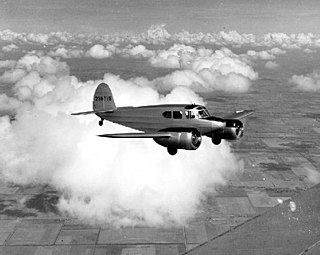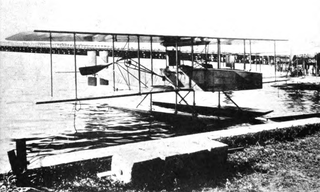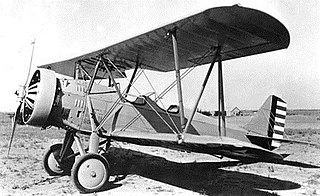
The Cessna AT-17 Bobcat is a twin-engined advanced trainer aircraft designed and made in the United States, and used during World War II to bridge the gap between single-engined trainers and twin-engined combat aircraft. The AT-17 was powered by two Jacobs R-755-9 radial engines. The commercial version was the Model T-50, from which the AT-17 was developed.
The 1911 Curtiss Model D was an early United States pusher aircraft with the engine and propeller behind the pilot's seat. It was among the first aircraft in the world to be built in any quantity, all of which were produced by Curtiss during an era of trial-and-error development and equally important parallel technical development in internal combustion engine technologies.

The Wright Model A was an early aircraft produced by the Wright Brothers in the United States beginning in 1906. It was a development of their Flyer III airplane of 1905. The Wrights built about seven Model As in their bicycle shop during the period 1906–1907 in which they did no flying. One of these was shipped to Le Havre in 1907 in order to demonstrate it to the French. The Model A had a 35-horsepower (26 kW) engine and seating for two with a new control arrangement. Otherwise it was identical to the 1905 airplane. The Model A was the first aircraft that they offered for sale, and the first aircraft design to enter serial production anywhere in the world. Apart from the seven machines the Wrights built themselves in 1906–1907, they sold licences for production in Europe with the largest number of Model As actually being produced in Germany by Flugmaschine Wright GmbH, which built about 60 examples.

The Aeronautical Division, Signal Corps (1907–1914) was the first heavier-than-air military aviation organization in history and the progenitor of the United States Air Force. A component of the U.S. Army Signal Corps, the Aeronautical Division procured the first powered military aircraft in 1909, created schools to train its aviators, and initiated a rating system for pilot qualifications. It organized and deployed the first permanent American aviation unit, the 1st Aero Squadron, in 1913. The Aeronautical Division trained 51 officers and 2 enlisted men as pilots, and incurred 13 fatalities in air crashes. During this period, the Aeronautical Division had 29 factory-built aircraft in its inventory, built a 30th from spare parts, and leased a civilian airplane for a short period in 1911.

The Aviation Section, Signal Corps, was the aerial warfare service of the United States from 1914 to 1918, and a direct statutory ancestor of the United States Air Force. It absorbed and replaced the Aeronautical Division, Signal Corps, and conducted the activities of Army aviation until its statutory responsibilities were suspended by President Woodrow Wilson in 1918. The Aviation Section organized the first squadrons of the aviation arm and conducted the first military operations by United States aviation on foreign soil.

The Burgess Company was a U.S. airplane manufacturer between 1910 and 1918.

The Curtiss N-9 was a floatplane variant of the Curtiss JN-4 "Jenny" military trainer used during World War I by the United States Navy.

The Wright Model B was an early pusher biplane designed by the Wright brothers in the United States in 1910. It was the first of their designs to be built in quantity. Unlike the Model A, it featured a true elevator carried at the tail rather than at the front. It was the last Wright model to have an open-frame tail. The Model B was a dedicated two-seater with the pilot and a passenger sitting side-by-side on the leading edge of the lower wing.

The Wright Model C "Speed Scout" was an early military aircraft produced in the United States and which first flew in 1912. It was a development of the Model B but was specifically designed to offer the Aeronautical Division, U.S. Signal Corps a long-range scouting aircraft.

The Burgess Model I, also known as the Burgess I-Scout and the Coast Defense Hydroaeroplane, was a United States reconnaissance seaplane built for the Aeronautical Division, U.S. Signal Corps in 1913. It was of conventional Wright Model B design but with an engine mounted amidships in an enclosed fuselage, driving by chains two large pusher propellers mounted on the interplane struts. The undercarriage consisted of twin pontoons. The single example built, S.C. No. 17, was delivered to the Army in January 1913 at the Burgess Company and Curtis factory in Massachusetts, then transported to Florida to complete the training of two officers. After the assignment, it was disassembled and moved to the Philippines in September 1913, where it was in and out of service several times before crashing into the sea near Corregidor on January 12, 1915. It is notable as the first U.S. Army aircraft to conduct two-way radio communication with the ground in December 1914.

The Curtiss Model E was an early aircraft developed by Glenn Curtiss in the United States in 1911.

The Loening OL, also known as the Loening Amphibian, was an American two-seat amphibious biplane designed by Grover Loening and built by Loening for the United States Army Air Corps and the United States Navy.
The Loening M-8 was a 1910s American fighter monoplane designed by Grover Loening and built by his Loening Aeronautical Engineering Company. An order of 5000 for the United States Army Air Corps was canceled when the First World War ended.

The Stearman Model 6 Cloudboy was a 1930s American training biplane designed and built by the Stearman Aircraft Company of Wichita, Kansas.

The Loening PW-2 was a 1920s American single-seat monoplane fighter designed by Grover Loening and built by his Loening Aeronautical Engineering Company.

The Loening S-1 Flying Yacht, also called the Loening Model 23, was an early light monoplane flying boat designed in the United States by Grover Loening in the early 1920s. The aircraft won the 1921 Collier Trophy.

The Dunne D.8 of 1912 was a tailless swept wing biplane, designed by J. W. Dunne to have inherent stability. One example was supplied to RAE Farnborough. License-built Burgess-Dunne models were used by the US Signal Corps and United States Navy and the short-lived Canadian Aviation Corps. It was the latter's first and only warplane.

The Curtiss Model J was a prototype tractor configuration aircraft that became the basis for the Curtiss Jenny series of aircraft.

The Loening SL was an American submarine-based reconnaissance flying boat designed and built by Loening Aeronautical Engineering for the United States Navy.

















